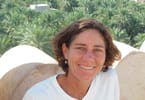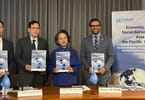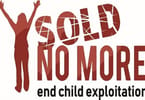Аялдарга жана Кыздарга инвестиция салуу
We’re seeing new innovations when it comes to how governments address crises, too. Of course, major policies often take years, decades even, to take root and make an impact. But once enacted and implemented, those policies can have far-reaching and long-lasting effects. In many ways, effective policymaking is the ultimate long-term investment.
Consider the pandemic’s economic gender divide: Even though each country has its own unique story to tell, we’re seeing that in high- and low-income countries alike, women have been harder hit than men by the global recession that was triggered by the pandemic. But—importantly—data also show that the negative effect on women has been smaller in countries that had gender-intentional policies in place prior to the pandemic.
That’s why we’re so encouraged to see governments around the world putting women at the center of their economic recovery planning and policymaking.
Pakistan expanded its Ehsaas Emergency Cash program to get money to poor households, with women making up two-thirds of the program’s intended recipients. Ehsaas provided emergency cash assistance during the pandemic to nearly 15 million low-income households—42% of the country’s population. And the effects will have a lasting impact: more than 10 million women being brought into the formal financial system for the first time.
Argentina recently published its first budget with a gender perspective, directing more than 15% of public spending toward programs that target gender inequality. With guidance from a newly appointed director of economy, equality, and gender in the Ministry of Economy, they’ve adopted policies that support women and families, such as establishing 300 new public childcare centers in the country’s poorest neighborhoods.
And in the United States, the Hawaiian state government is putting women and girls—as well as Native Hawaiians, immigrants, transgender and nonbinary people, and people living in poverty—at the center of its economic recovery efforts. The first gender-oriented economic recovery plan in the United States includes proven policies that support women’s long-term economic empowerment, such as paid sick days and family leave, universal childcare, and raising the hourly minimum wage for single mothers.
We’re eager to see the long-term outcomes from these innovative approaches toward women’s economic empowerment. But even in this early phase, these are encouraging new models of policymaking. These policies won’t just make a difference in the short term; they’ll help ensure greater economic stability the next time a crisis comes around.
Ал тургай, андан да тез
If the past year has shown us anything, it’s this: Simply addressing the crisis at hand means we’ll always be playing catch-up. To make future “miracles” possible, we need to think in generations, not in news cycles.
Long-term investments are rarely the exciting, easy, or politically popular thing to do. But those who have made them have seen meaningful returns amid a crisis of historic proportions. So many of the groundbreaking innovations of the past year have one thing in common: They grew out of seeds that were planted years—or even decades—earlier.
So, it’s clearer than ever that we need more governments, multilateral organizations, and foundations like ours to make forward-thinking investments, knowing that the returns might be many years down the road. We must work with others to support talented researchers around the globe to identify new tools and technologies that could be building blocks for solving a multitude of challenges. And we must strengthen collaboration across countries and sectors to work together toward common goals.
But it’s not enough for high-income countries to simply keep investing money and resources internally and hoping their game-changing innovations make their way to the rest of the world. We also need to invest in R&D, infrastructure, and innovation of all kinds closer to the people who most stand to benefit.
Жаңы инновация булактары
We’ve seen that COVID-19 vaccine access is strongly correlated with the locations where there is vaccine R&D and manufacturing capability. Latin America, Asia, and Africa are being hit particularly hard by the delta variant right now because so much of their population remains unvaccinated. Africa, in particular, has had difficulty getting access to the doses they need. The continent—home to 17% of the world’s population—has less than 1% of the world’s vaccine manufacturing capabilities. If African leaders, with donor support, invest in and build a sustainable regional vaccine development and manufacturing ecosystem, the continent would be far less likely to be last in line in a future pandemic.

That’s why we’re supporting the Africa CDC and African Union’s vision to do just that by 2040. It’s not only Africa that would benefit from improved health security and pandemic preparedness; the entire world would benefit from new sources of R&D and scientific innovation.
Africa is committed to establishing mRNA manufacturing on the continent, and already, mRNA companies are stepping up to make that a reality. This will allow Africa to create vaccines not just for COVID-19, but potentially also for malaria, tuberculosis, and HIV—diseases that disproportionately affect the most vulnerable.
Our call to invest closer to the source is a reflection of our belief in the ability of people all over the world to innovate and solve tough problems. The next big idea or lifesaving breakthrough can be sparked anywhere in the world, at any time. Whether the world will benefit is up to all of us.
Кризистерге жооп берүү алар боло электе эле башталат.
It’s not difficult to imagine a world in which Dr. Karikó’s revolutionary ideas about mRNA never got the funding they needed. Or a world in which Africa didn’t have its own genomic sequencing capacity—and the beta variant couldn’t get sequenced in time to act quickly.
The pandemic has taught the world an important lesson: Responding to crises starts years before they happen. And if we want to be better, faster, and more equitable in our approach to realizing the Global Goals by 2030, we need to start laying the foundation. Now.

Адаптацияга чакырык: таасир үчүн новаторлор
Just as countries, communities, and organizations have been innovating during COVID, millions of individuals around the world have shown us that each of us—all of us—can also make a mark. These are three such thinkers and makers. They help birth ideas, designs, and babies. They are doers, driven by passion, knowledge, and the unstoppable will to solve problems, and are undeterred by challenging times. When COVID-19 battered the world, it only fortified their spirit. With renewed resilience and determination, they shifted what they did and how they worked. For them, the pandemic became a call to adapt. And to do better. Introducing you to them is just the beginning. We will continue looking to tell the stories of the many more who are blazing trails for a better world.

Вакциналар үчүн инновациялар: Масийивага умтулуңуз
In May 2020, when the world was scrambling for PPE, testing kits, and ventilators, Zimbabwean mobile telecommunications mogul Strive Masiyiwa accepted a gargantuan challenge. Newly appointed as one of the African Union’s special envoys for COVID response, he embarked on a high-speed chase to help get Africa’s 1.3 billion residents much-needed medical supplies.
“The global supply was so limited, and it became a battle. Africa was edged out,” he said at the time. Reporting to seven African presidents who, along with Africa’s CDC, made up the continent’s joint COVID-19 Task Force, the challenge was clear: “My job is to fix the problem in front of me. How do I ensure those critically required supplies are moving?” he says.
Strive has made a career of trying to fix the problems in front of him. In 1991, the young entrepreneur was asked by a multinational corporation to help bring satellite phones to Africa. If he raised US$40 million, he’d get 5% of the company and a cut of each phone eventually sold on the continent. But after two years of trying, he did not succeed. Discouraged, Strive went back to his construction business, until the lessons coalesced. Using a Global System for Mobiles (also known as GSM and 3G) seemed like a big opportunity to bring phones to the continent himself. “Suddenly, all the things I had learned … became a massive windfall. It was like I had advanced 25 years as an entrepreneur!” he says.

Fast-forward to COVID-19. Just 28 days after his appointment, Strive assembled a technical team to develop and launch the African Medical Supplies Platform (AMSP), a user-friendly online marketplace for Africa’s 55 governments to access COVID-related medical supplies, streamline logistics, and consolidate buying power for things like Lumira test kits and treatments like dexamethasone. Strive and his team also created a pipeline for high-tech ventilators to be manufactured in South Africa, reducing the cost tenfold. And later, when COVAX vaccine deliveries to the continent were delayed, Strive not only worked to secure contracts independently through the African Vaccine Acquisition Task Team (AVATT), but also helped ensure that vaccine manufacturing would take place in Africa. The World Bank and African Union estimate that by January 2022, African manufacturers will have participated in the production of up to 400 million doses for local distribution.
A fierce critic of highly resourced nations “pushing their way to the front of the queue to secure production assets,” Strive rejects vaccine nationalism, a stance that has—in many ways—defined his work. “We didn’t ask anyone to give us anything for free,” he insists. “Equitable access meant buying vaccines the same day and time they became available.”
Largely pausing his day job during the pandemic, Strive has spent the last year negotiating to help reduce vaccine inequities between rich nations and African ones and has become part of the brain, engine, and heart of Africa’s massive homegrown COVID-19 response. “When we talk about philanthropy, we often talk about money. But this is a once-in-a-lifetime crisis, and the scale of it, both in terms of human cost and human life, as well as economic cost, is pretty profound. You just have to drop what you are doing and tackle it,” he said.

Жаңы төрөлүү: Efe Osaren
Efe had just arrived at the hospital when everything changed. Minutes before, when New York City announced its COVID-19 lockdown, she was barreling underground in the subway, mentally reviewing her client’s case: older woman, bed rest, likely preterm C-section, baby that would be delivered straight to the NICU. For first-time mothers, especially those in high-risk pregnancies, birth can be a traumatic experience. For Efe, her job as a doula meant holding their hand through the unchartered journey, ensuring that stress didn’t harm mom and baby alike. Except that on this most anticipated of March dates, an invisible virus barricaded her from the delivery room.
Efe Osaren was 15 when she became enthralled by a unique ritual in which her newborn niece was stretched and massaged with palm oil and hot rags. It was a traditional Yoruba bath, and her mom told Efe she’d been bathed that way too, so she’d grow up with strong bones. The bath didn’t make Efe unbreakable, but it did mold her. The Nigerian American student living in Texas knew then she wanted to use tradition and science to help babies come into the world in health. Especially babies born to women of color.
In the United States, new Black moms die at higher rates than white ones—irrespective of age, education, rural or urban residence, or socioeconomic status. Black mothers are three times more likely to die in childbirth than white ones. “It makes me feel rageful for my clients,” says Efe. It’s why she also works as a reproductive birth justice advocate. “Pregnancy requires you to feel safe. When you don’t have comfort, you have fear…that can lead to medical emergencies.”
Back in a NYC hospital, she encountered her own worst fear—she would not be able to be there with her client. With no time to lose, she summoned her client’s partner and gave him a crash course in the lobby: how to help mom breathe, how to keep her calm with eye contact, how to press on her hips and back, how to instill confidence in her, how to ensure that if she’s wheeled into the OR, she will be safe.
The flash training became the blueprint for Efe’s pivot during COVID. She began teaching virtual birthing classes, empowering her clients through knowledge, and even helping them get tripods and Bluetooth speakers for their phones so they could video chat during labor.
An advocate for women of color her whole career, Efe now equips them to do the job themselves. It is not an easy task, because she has become bodyguard, concierge, therapist, and mediator. But she knows her work is important.
Note: While research shows that specific interventions can improve the birth experience for moms, more research and funding are needed to identify interventions that reduce racial inequity in maternal outcomes. Accordingly, obstetric quality improvement programs that represent current best practices should be expanded and standardized.


PPE үчүн инновациялар: Kuldeep Aryal
On April 25, 2015, Kuldeep Aryal was in his room studying for his college civil engineering exams when a massive earthquake ripped Nepal open. After spending interminable minutes hiding under his home’s structural beams and clinging onto life with nothing but a prayer, Kuldeep went outside and found his neighbor’s home on the ground. It was one of 700,000 houses that had crumbled in the quake.

As he began lifting bricks and tiles, a question arose from under the rubble. “How much do I want my engagement with the world to have impact?” he asked himself. And a humanitarian was born. “I never looked back.” What he did not know then was how his work in Nepal’s response and recovery effort would end up informing how he’s done everything since.
When COVID-19 hit South Asia, Kuldeep was living in Dhaka. Like all other nations on the planet, Bangladesh was also struggling to source PPE, to create systems for contact tracing, and to get clarity about what it meant to be locked down at home indefinitely. But hope, it turns out, was abundant. “This was a triggering event. I went onto chat groups, we open-sourced medical supplies, and we started sharing ideas about how to make things ourselves,” he said. He connected with universities who could help him with 3D printers. He mobilized resources. And within weeks, he was producing face shields for his community.
БУЛ МАКАЛАДАН ЭМНЕ АЛУУ КЕРЕК:
- And in the United States, the Hawaiian state government is putting women and girls—as well as Native Hawaiians, immigrants, transgender and nonbinary people, and people living in poverty—at the center of its economic recovery efforts.
- With guidance from a newly appointed director of economy, equality, and gender in the Ministry of Economy, they've adopted policies that support women and families, such as establishing 300 new public childcare centers in the country's poorest neighborhoods.
- The first gender-oriented economic recovery plan in the United States includes proven policies that support women's long-term economic empowerment, such as paid sick days and family leave, universal childcare, and raising the hourly minimum wage for single mothers.





















